The 9x19mm Uru submachine gun, created in the mid-1970s by Brazilian designer Olympio Vieira de Mello Filho and placed into series (though, limited) production in the early 1980s by Mekanika Indústria e Comércio Ltda. in Rio de Janeiro, has already been the subject of a number of printed and on-line articles from the eighties till now. Having myself produced most of them, I would recommend this one at Dan Shea’a Small Arms Review website (https://www.smallarmsreview.com/display.article.cfm?idarticles=2009) as the basic one in terms of historical and technical details within the space limitations available. In addition to that, Ian at Forgotten Weapons more recently added a very interesting video on the gun (https://www.youtube.com/watch?v=D_dXVwZb33Q), having much earlier reproduced in FW one of my 1980s articles in Harris Publications’ FULL AUTO magazine. So, what’s new, then?
Having recently browsed through some of my old photo negatives files, I just happened to find some pics that apparently have never been published, so I decided to bring them to light. Hope you find them of some interest. BTW, the featured image above was intended to be used in a Mekanika promotional pamphlet, and shows a grey-and-black painted camo Uru fitted with two magazines taped together and its dedicated sound suppressor duly wrapped in camo fabric. The “operator’s” ID will be kept off the records…

The original Uru prototype made by Olympio Vieira de Mello Filho in 1974. Note shallower magazine housing, smaller trigger guard, disc-shaped fire selector, wooden pistol grip, and differently-shaped removable stock.

A pre-series Uru, as submitted to official Brazilian Army product-certification tests at the Marambaia Proving Grounds, in Rio de Janeiro.


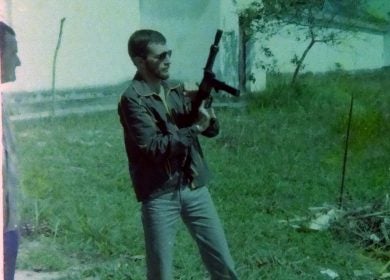
Author (the skinny guy), Olympio, and a Uru at Brazilian Army’s Marambaia Proving Grounds, in Rio de Janeiro, mid-1981. The subject of attention was the gun’s just-created “Type 1” screw-on compensator/muzzle brake.

Attached to a specially threaded muzzle, the first type of compensator/brake device created for the gun added about 100mm to the overall length. Note single upward transversal port.

The gun with the add-on accessory in place and the original sling.

The same gun, 30-rd magazine and metal stock detached. What one was supposed to do with the latter when removed from gun was the subject of many jokes, all of them unpublishable…

A couple of years later (i.e. in 1983) Olympio came out with a “Type 2” compensator/muzzle brake, whose external diameter was the same of the gun’s cylindrical receiver. Note the three upward ports slightly turned to the left to somewhat compensate the slight LH torque movement induced to the weapon when firing a bullet.
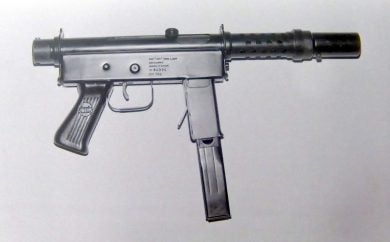
The Uru with the “Type 2” appendix, which was attached to place with a hex key (a.k.a. Allen wrench). Lots of people liked to fire the SMG in this stockless configuration.

The gun with the normal 175mm barrel in place. Also displayed are a standard barrel with an added-on, second-model muzzle brake/compensator and the original dedicated sound suppressor with an integral 75mm barrel.

This is how my long-time friend and part-time gun wizard Eduardo Ferreira Neto liked to “spray and pray” with a stockless Uru in the range, sometime in the early 1980s. Cyclic rate of fire was in the region of 700 rounds per minute.
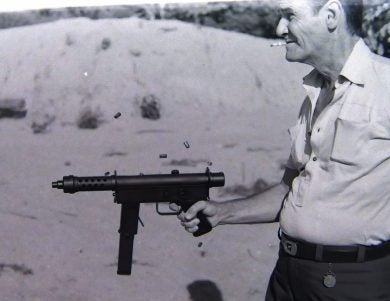
In this photo, however, Olympio shows how he liked to fire his baby: single-handed, at full-auto (about seven cartridge cases caught by camera in the air), and a cigarette between lips (heavy smoking led to his death). Although he was, basically, left-handed (see photos below), he was using his, eh, “weak” hand in photo.

Yes, he was also able to fire according to the book. Fire-selector top-pointing position (SA) shows that he was using the semi-auto mode, while wearing glasses indicates that he meant to use the gun’s sights.

The designer using a makeshift support to fire (one cartridge case caught by camera in the air) an Uru fitted with an experimental sound suppressor that had its own adjustable sights to allow more precise shootings at 100 meters or so.

A better view of the experimental suppressor showing the massive ears that protected the sights: rear, open U-notch; front, post adjustable for windage and elevation. The whole thing weighed about 1kg, but was very effective both in terms of sound reduction and firing accuracy.

Shown beside a standard barrel, a longitudinally-cut sound suppressor shows (A) built-in 75mm barrel, (B) 32mm expansion chamber, (C) mounting nut, and (D) 48 conical baffles.

The Uru no-frills fixed sights consisted of a rear 2mm-diameter peep hole and a tiny blade front sight (indicated by arrow), radius being 230mm. The integral metal loops to the left side are for sling attachment.

Some disassembly steps: (1) Using an ammo round to unlock a spring-loaded retaining pin to allow (2) separation of upper and lower receivers. By unscrewing its integral mounting nut, the barrel is pulled out (3), then followed by the bolt/guide rod/return spring assembly (4). Other steps were the sideways removal of the fire selector (5) and the single-piece magazine release lever/ejector (6).

Magazine included, full disassembly of the Uru resulted in only 21 parts, no tools required and taking less than one minute. As Olympio used to say: “The fewer the parts, the smaller the chances of a malfunction.” Some elements had dual or triple purpose in the gun.
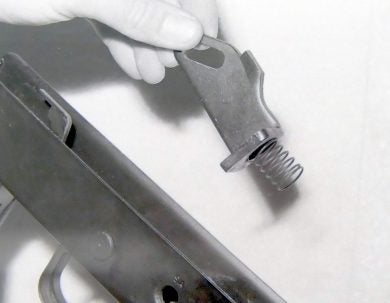
An important item inside the Uru was the inertia-actuated bolt-locking system. A butt blow, as in the case of a fall, made this part press against the helical spring and raise it, immediately blocking the bolt’s travel rearwards and not allowing it to feed a round to the chamber and fire it.

To compensate for the not-practical, detachable tubular stock, a small batch of a very adequate wire folding stock, spring-loaded to the open and folded positions, was made available for interested parties to evaluate.

Author firing a suppressed Uru (sights-fitted tube) using the foldable wire stock, which he always insisted on being on the gun for all tests and demonstrations he participated in.

Early in 1986, a few months before passing away, Olympio made this prototype of what he called the Uru II. Virtually unchanged in its internals, the gun displayed a number of external changes, such as the longer trigger, wooden handguard, adustable protected sights with a longer radius, and redesigned sling attachment points.

The sole Uru II variant totally disassembled. Note the foldable wire stock that attached to the rear of the cylindrical receiver.

While briefly manufactured in São Paulo by the Bilbao S.A. company (a.k.a. FAU Guns) in the late 1980s, a so-called Uru Modelo II received a grip-safety element to replace the inertial bolt locking system.

Exploded view showing the grip-actuated safety components added to the gun.

The same São Paulo-based company also made small numbers of a longer-barrel, semi-auto-only 9x19mm carbine variant of the Uru for possible sales in the commercial market, which never happened.
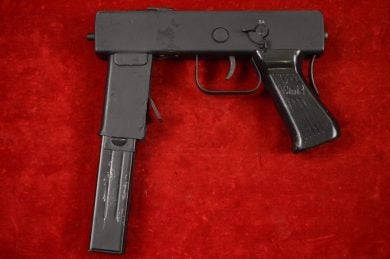
This Bilbao S.A. lower receiver alone (s/n 00459) somehow appeared in an auction in the U.S. some time ago. Note redesigned fire selector in the SA top position (Safety would be forward).
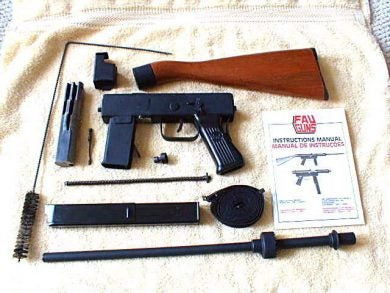
These Bilbao/FAU Guns parts, minus tubular upper receiver, for its semi-auto carbine showed up for an auction in the U.S., Instructions Manual included.

The very last attempt to make the Uru hit the market came in 1998 when this variation, noteworthy by its foldable tubular stock, received official Brazilian Army production certification. The effort was the responsibility of a Rio de Janeiro firm called PLANEV that made a joint venture with the Amadeo Rossi company, in São Leopoldo, Rio Grande do Sul State. To no avail.

Well, folks, here’s a departing picture of Olympio’s child and one of my all-time favorite Brazilian guns, as you have probably noticed…
 Your Privacy Choices
Your Privacy Choices
